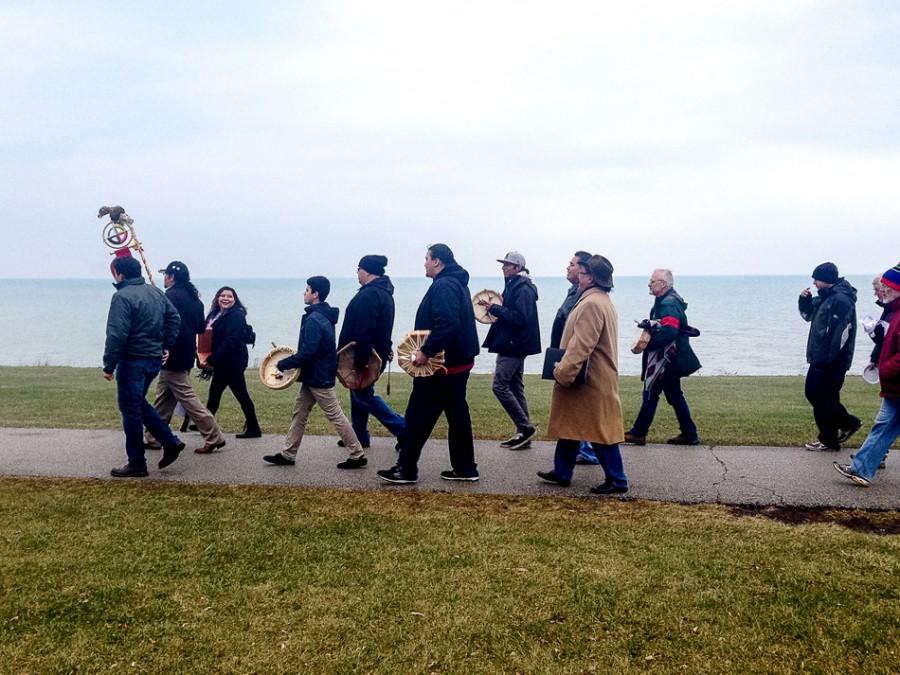NAISA, community members commemorate Sand Creek Massacre anniversary
Alice Yin/The Daily Northwestern
A group of Evanston and Chicago community members march along The Lakefill on Saturday afternoon. The crowd gathered for a commemoration of the Sand Creek Massacre held by the Native American and Indigenous Students Alliance.
November 23, 2014
Members and friends of the Native American community held a remembrance of the Sand Creek Massacre at Northwestern on Saturday.
The event was organized a week before the 150th anniversary of the tragedy, in which U.S. soldiers brutally attacked a Cheyenne and Arapaho encampment. Hosted by the Native American and Indigenous Student Alliance, the commemoration also prompted the community to acknowledge NU co-founder John Evans’ role in the massacre. It was part of NAISA’s programming to observe Native American Heritage Month.
Lorenzo Gudino, a Medill sophomore who helped plan the event, said he wanted its impact to reach the NU administration, which received recommendations from the Native American Outreach and Inclusion Task Force this month on how to better integrate Native American culture and history into the University.
“I hope President Schapiro gets to see how this plays out,” Gudino told The Daily. “Hopefully the provost takes those recommendations that were provided by the task force and tries to implement them appropriately.”
The program Saturday began at The Arch with a prayer and song. Attendees then went into Harris Hall to hear a series of speakers from the Chicago area Native American community.
About 80 people attended, including NU students, alumni and faculty. Associates of local Native American centers, University of Illinois at Chicago faculty members and Native American musicians and military veterans participated. Prof. Amy West, a UIC faculty member of Southern Cheyenne descent, spoke about the need for herself and the community to remember the massacre.
“It was emotional,” West told The Daily. “I actually drew from Cheyenne spiritual tradition to talk about the lessons we might learn that might help guide us as we move forward.”
The group then marched to The Lakefill along a path of paper moccasins. After circling around the bonfire pit, Gudino’s father ignited the flames.
Father Peter Powell, the spiritual director of St. Augustine’s Center for American Indians and an honorary Cheyenne chief, spoke again at the bonfire, incorporating first-hand accounts of the genocide. On the day of the Sand Creek Massacre, Nov. 29, 1864, about 150 people were killed, most of them women and children.
“These are the sacrifices they made,” Powell said. “These are the accounts from those that survived.”
Bethany Hughes, a student at The Graduate School, noted that the event’s turnout showed the NU and Chicago communities’ desire to recognize the tragedy.
“I was thinking through it, imagining what it would have been like,” Hughes said. “In American history, we tend to not want to go into detail because it’s gruesome and painful. But I was really sort of honored by the opportunity to, as a group, bear witness to the trauma and the atrocity that happened.”
Powell concluded his reading with a prayer. West then led a tradition of throwing tobacco into the bonfire, with members of the audience joining in. A group of singers and drummers performed at the close of the event.
“I was appreciative given the responsibility of knowing this and being able to have that as part of my own life and understanding of what it means to be a person now, a native student at Northwestern,” Hughes said.
Email: [email protected]
Twitter: @alice__yin
Previous stories on this topic:
University releases report on outreach, inclusion for Native Americans
Students demand Native American studies, recognition of Evans’ role in massacre


